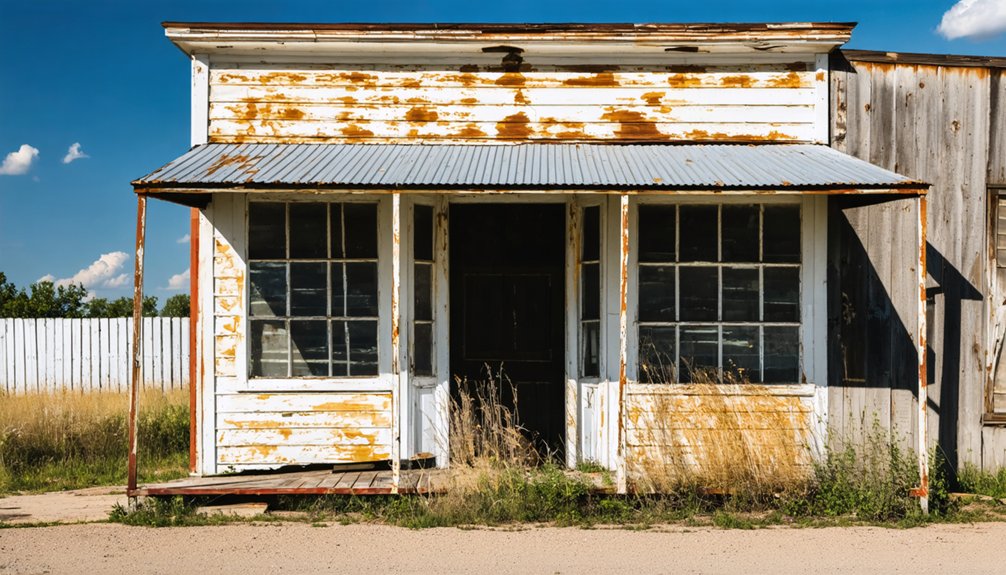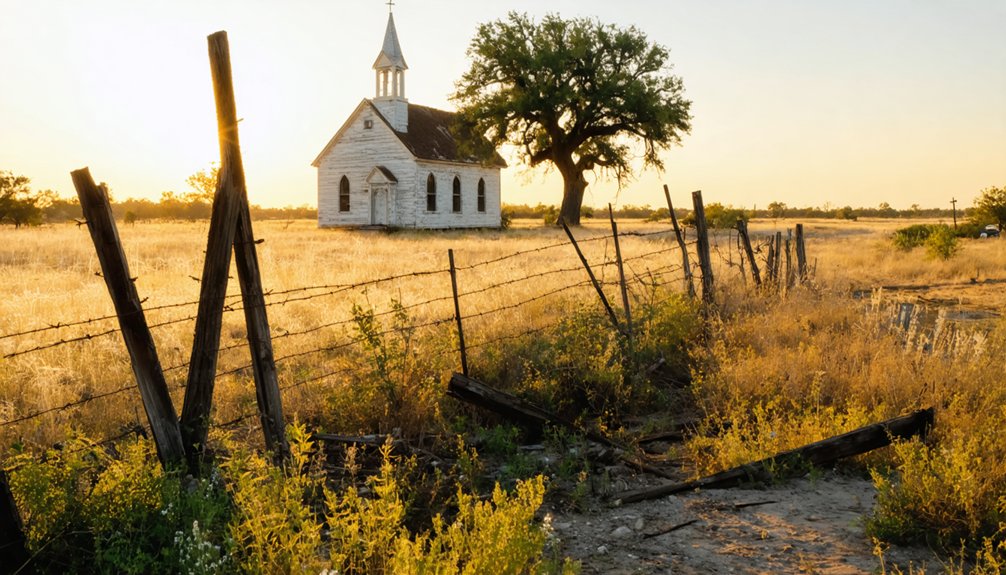You’ll find Dido, Texas near present-day Fort Worth, established in 1848 as an agricultural community named after Queen Dido of Carthage. The town thrived initially with a post office and local stores, but when railroads bypassed it in the 1880s, Dido’s fate changed dramatically. Today, this ghost town retains few original structures, though its cemetery, Methodist church, and connection to musician Townes Van Zandt keep its pioneer spirit alive. The layers of Dido’s past hold surprising stories beneath its quiet surface.
Key Takeaways
- Dido became a ghost town after railroads bypassed the community in the 1880s, causing economic decline and population loss.
- Originally established in 1848 as an agricultural community near Fort Worth, Dido now consists of few remaining structures.
- The historic Dido Cemetery, with over 1,000 pioneer memorials, remains as a testament to the town’s former significance.
- The Dido Methodist Church, established in 1894, stands as one of the last surviving landmarks of the ghost town.
- Local bars serve as modern gathering places for remaining residents, maintaining social connections in the largely abandoned town.
The Rise and Fall of a Texas Settlement
While many Texas settlements flourished during the mid-1800s, Dido’s story captures both the promise and precariousness of frontier development.
You’ll find its origins in 1848 when settlers established this agricultural community near present-day Fort Worth, naming it after the legendary Queen of Carthage. The town’s early years showed potential, with a post office and local stores serving the growing population of farmers and homesteaders. Just as Queen Dido’s Carthage became a prosperous trading center, the Texas settlement initially showed signs of economic growth.
Yet Dido’s fate would turn on transportation impact. When railroads emerged in the 1880s, they bypassed the settlement in favor of nearby towns like Saginaw.
This significant development sparked economic challenges that proved insurmountable. You can trace Dido’s decline as businesses closed, residents departed, and its infrastructure crumbled, eventually leading to its ghost town status. Today, the community maintains its social bonds through two popular bars that serve as gathering places for local residents.
Hidden History at Dido Cemetery
Since its first marked burial in 1878, Dido Cemetery has stood as a sacred chronicle of pioneer life in northern Tarrant County. It began with Amanda Thurmond’s grave and grew through generous land donations from Dempsey S. Holt in 1887 and Dr. Isaac L. Van Zandt in 1894. The village’s unique name was inspired by the Queen of Carthage, reflecting the region’s rich cultural heritage. Just as her ancient namesake showed remarkable leadership in establishing Carthage, this Texas town demonstrated pioneering ingenuity in building a new community.
You’ll find over 1,000 pioneer memorials here, including Confederate veterans and influential Texas musician John Townes Van Zandt. The burial practices reflect changing times, from simple pioneer markers to modern headstones, yet strict preservation rules maintain the cemetery’s historical integrity.
A Texas Historical Commission marker, placed in 1977, guides you through the site’s significance, while the adjacent Dido Methodist Church – Tarrant County’s oldest – continues to serve as a gathering place. Together, they’re the last physical reminders of Dido’s once-thriving community.
From Early Pioneers to Ghost Town Status

The pioneer settlement of Dido took root in 1848, establishing itself as a hardworking agricultural community in what would become northern Tarrant County.
Like early Texas towns such as Red River Station, Dido was established to serve the needs of pioneers in the region.
In later years, the area was renamed Saginaw in 1880s to reflect J.J. Green’s Michigan roots.
You’d have found a thriving town with its own post office, stores, and churches, where early settlers faced the pioneer challenges of carving out a life from the Texas soil.
Everything changed when the railroad bypassed Dido in the 1880s, choosing nearby Saginaw instead.
This economic shift proved fatal to the town’s future. You’d have watched as your neighbors moved away, seeking opportunities in rail-connected communities. Local businesses shuttered one by one, until only scattered homes and ruins remained.
While a small number of caretakers and descendants still maintain ties to Dido through its historic cemetery and community gatherings, the once-promising settlement has earned its ghost town status.
Cultural Legacy and Musical Connections
Though Van Zandt made his name in Austin and Nashville, his connection to this Fort Worth area adds depth to Dido’s cultural tourism appeal.
Like many early Texas settlements, Dido faced challenges due to lack of railroads that limited its economic growth.
The town’s heritage lives on through local gatherings near Eagle Mountain Lake, where musical storytelling and family histories intertwine.
The Dido Methodist Church continues serving as a community anchor, while Van Zandt’s powerful influence on Texas music guarantees this quiet town’s place in the state’s rich cultural tapestry.
Preserving Dido’s Historical Heritage
While modern development threatens many historic sites in Texas, preservation efforts in Dido focus on protecting its most significant landmarks: the Dido Methodist Church and Cemetery.
You’ll find the church, established in 1894, stands as Tarrant County’s oldest, earning National Register status in 1978.
Today’s preservation strategies include active community engagement through local women’s organizations and volunteer groups who maintain both the church building and cemetery grounds. The cemetery notably contains the Van Zandt burial plot, where the ashes of renowned musician Townes Van Zandt were scattered.
The University of North Texas Libraries’ digital archives preserve Dido’s newspapers and historical records, while oral histories capture the town’s cultural heritage. Through the Tocker Foundation grant, these materials are now freely accessible to researchers and the public.
Despite challenges from residential development and limited funding, you can witness ongoing preservation work through regular community events, historical education programs, and coordinated efforts between local organizations to protect these essential pieces of Texas history.
Frequently Asked Questions
What Happened to the Original Buildings and Homes in Dido?
You won’t find the original structures anymore – they’ve vanished as folks moved away after the railroad bypassed town. Only the church and cemetery remain, preserved through historical preservation efforts.
Are There Any Ghost Stories or Legends Associated With Dido?
You won’t find documented haunting tales or ghost sightings in Dido. Unlike other Texas ghost towns, local history focuses on community preservation and genealogy rather than supernatural legends or paranormal activity.
Can Visitors Explore the Area Freely, or Are There Access Restrictions?
Like a fortress guarding its secrets, you can’t explore freely. Access guidelines require permission since it’s private property, and visitor safety concerns mean you must respect posted restrictions and boundaries.
What Caused the Three Rail Lines to Eventually Stop Operating?
You’ll find rail line decline occurred as automobiles and trucks offered more flexible transportation changes, reducing freight demand and passenger traffic until operations became unprofitable and eventually ceased in the region.
Do Any Descendants of Original Dido Settlers Still Live Nearby?
You’ll find descendants maintaining strong local history connections in nearby towns like Saginaw and Eagle Mountain, with many actively participating in events at Dido Methodist Church and preserving their ancestral legacy.
References
- https://kids.kiddle.co/Dido
- https://www.loquis.com/en/loquis/6659341/Dido+Texas
- http://kitsussite.ddns.net:3171/content/wikipedia_en_all_maxi_2024-01/A/Dido
- https://www.texasalmanac.com/places/dido-0
- https://texashighways.com/culture/capturing-the-spirit-of-townes-van-zandt-in-fort-worth/
- https://www.texasescapes.com/EastTexasTowns/Dido-Texas.htm
- https://www.texasescapes.com/TexasGhostTowns/DidoTexas/DidoTexas.htm
- https://didocemeterytexas.org
- https://www.ghosttowns.com/states/tx/dido.html
- https://en.wikipedia.org/wiki/List_of_ghost_towns_in_Texas



